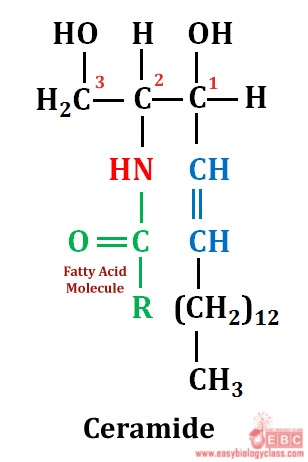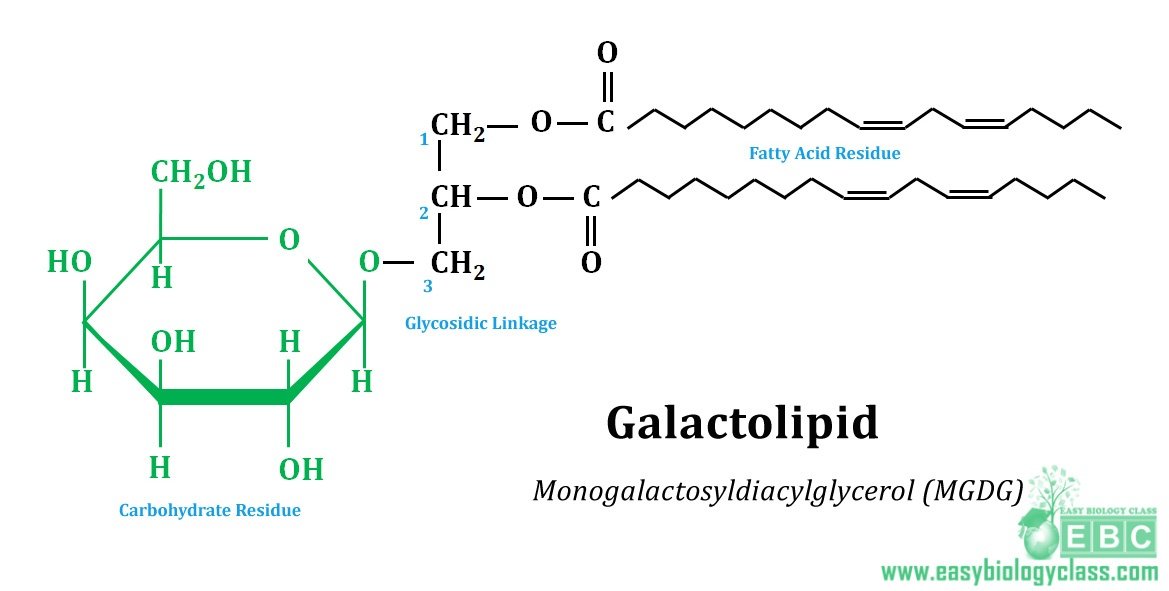Biochemistry MCQ-11: Membrane lipids are a type of lipid that are important components of cell membranes. The main types of membrane lipids are phospholipids, galactolipids, sphingolipids and cholesterol. The composition of membrane lipids can vary between different types of cells, and can be influenced by factors such as diet and disease. This Biochemistry MCQ on Plasma Membrane Lipids will help you to study the structure, classification and functions of different classes of Membrane Lipids.
Learn more: Membrane Lipids Notes | Membrane Lipids PPT
(1). A genetic disorder caused by mutation in the hexosaminidase enzyme A which hydrolyze the GM2 to GM3 during membrane lipid turnover:
a. Tay-Sachs syndrome
b. Fabryi disease
c. Gauche’s disease
d. Niemann-Pick disease
(2). The simplest hydrophilic moiety present in the membrane lipid is:
a. Phosphate group
b. Hydroxyl group
c. Amino group
d. Glucose
(3). Which of the following cellular event can be best regulated by prostaglandins?
a. Synthesis of inter cellular cyclic AMP
b. Synthesis of intra cellular cyclic AMP
c. Synthesis of inter cellular cyclic GMP
d. Synthesis of intra cellular cyclic GMP
(4). Which of the following statement is true regarding the solubility of steroids in biological fluids?
a. Steroids and cholesterols are equally soluble
b. Steroids are more soluble than cholesterol
c. Cholesterol are more soluble than steroids
d. Cholesterol and steroids are completely insoluble
(5). The potent molecular signal molecule Platelet Activating Factor (PAF) is an example for:
a. Glycolipid
b. Phospholipid
c. Ether lipid
d. Ceramide
(6). Thylakoid membrane of chloroplast are rich in:
a. Galactolipids
b. Phospholipids
c. Cardiolipin
d. Sphingolipids
(7). How many double bonds occur in Arachidonic acid?
a. 1
b. 2
c. 3
d. 4
(8). _______ is considered as the structural parent of all sphingolipids:
a. Sphingosine
b. Ceramide
c. Lecithin
d. Sphyngomylein
(9). Which among the following is the most complex sphingolipid?
a. Cerebroside
b. Gangleoside
c. Globoside
d. Ceramide
(10). A genetic disorder caused by the accumulation of sphingomyelin in brain is called:
a. Tay-Sach syndrome
b. Gout
c. Niemann-Pick Disease
d. Gauche’s disease
(11). Lipid molecule involved in the bio-signaling pathway that include membrane turnover and exocytosis is ________.
a. Phosphatidylinositol
b. Phosphatidyl glycerol
c. Myoinositol
d. Phosphatidyl glycerol and Myoinositol
(12). The precursor of eicosanoids, a paracrine hormone, in human is _________.
a. Squaline
b. Cholesterol
c. Arachidonic acid
d. Ceramide
(13). Which of the following is NOT an eicosanoic acid in human?
a. Prostaglandin E1
b. Thromboxane A2
c. Leukotriene A4
d. Arachidonic acid
(14). Which of the following is not an NSAID (Non-steroidal Anti-inflammatory Drug)?
a. Aspirin
b. Ibuprofen
c. Meclofenamate
d. Omepazole
(15). NSAIDs inhibit cellular inflammation by inhibiting ___________ enzyme(s).
a. Prostaglandilin H2 Synthase
b. Clycooxygenase
c. COX
d. All of these
(16). NSAID inhibit inflammation by preventing the conversion of:
a. Membrane phospholipid to arachidonic acid
b. Arachidonic acid to prostaglandin E2
c. Prostaglandin E2 to thromboxane A2
d. All of these
(17). Most abundant membrane lipid in the biosphere is:
a. Phospholipid
b. Galactolipid
c. Sphingolipid
d. Ether lipid
(18). Enzymes for beta oxidation of fatty acids are located in
a. Mitochondria
b. Mitochondria and cytoplasm
c. Mitochondria and Golgi
d. Mitochondria and peroxisome
(19). For the detection of which biological compound, the Salkowski test is done?
a. Fatty acids
b. Glycerol
c. Ceramide
d. Cholesterol
(20). Steroids are oxidized derivatives of sterols. They have ____________
a. Sterol nucleus but lack the alkyl chain attached to the ring D of cholesterol
b. Sterol nucleus with two alkyl chain attached to the ring ‘D’ of cholesterol
c. Sterol nucleus without CH3 between ‘C’ ring and ‘D’ ring of cholesterol
d. Sterol nucleus with two CH3 between ‘C’ and ‘D’ ring and ‘A’ and ‘B’ ring of cholesterol
(21). Receptors for steroid hormones usually reside at ______.
a. Plasma membrane
b. Cytoplasm
c. Nuclear membrane
d. Nucleoplasm
e. Plasma membrane and nuclear membrane
(22). Prednisolone and Prednisone are anti-inflammatory drugs, they are chemically __________.
a. Glycerol derivatives
b. Steroids
c. Amino alcohols
d. NSAIDS
(23). Cerebroside is a:
a. Phospholipid
b. Sphingolipid
c. Aminolipid
d. Glycolipid
(24). Glyco-sphingolipids are a combination of:
a. Glycerol with two galactose residues
b. Ceramide with one or more sugar residues
c. Sphingosine with galactose and ceramide
d. Sphingosine with glucose
(25). What is the molecular formula of cholesterol?
a. C27H45OH
b. C28H47OH
c. C29H47OH
d. C23H41OH
You may also like NOTES in...
BOTANY BIOCHEMISTRY MOL. BIOLOGY
ZOOLOGY MICROBIOLOGY BIOSTATISTICS
ECOLOGY IMMUNOLOGY BIOTECHNOLOGY
GENETICS EMBRYOLOGY PHYSIOLOGY
EVOLUTION BIOPHYSICS BIOINFORMATICS
Answer Key and Explanations
1. Ans. (a). Tay-Sachs syndrome
Tay-Sachs syndrome is a fatal autosomal recessive disorder in human caused by the mutation in hexosaminidase A enzyme (HEXAA gene) which hydrolyze the GM2 to GM3 during membrane turnover in the cells. The disease is characterized by the progressive deterioration of nerve cells and mental and physical retardation. The disease is exactly caused by the accumulation of large quantities of cell membrane lipid ‘gangliosides’ in the nerve cells of brain.
2. Ans. (b). Hydroxyl group
The hydrophilic groups on the membrane lipid form the ‘head’ of membrane lipids. There are a wide diversity polar compounds contribute the ‘head’ group of the membrane lipids such as carbohydrates, amino acids, phosphate groups, sulphate groups etc. The hydroxyl group is also polar and thus, the un-esterified –OH group of glycerol moiety of membrane lipid can also act as the polar head group, in fact the simplest hydrophilic moiety in any membrane lipids.
For details: Membrane lipids: Properties, Structure and Classification
3. Ans. (b). Synthesis of intra cellular cyclic AMP
Prostaglandins (PG) are hormone like compounds derived enzymatically from fatty acids. They act as both autocrine and paracrine signal factors in the target cells. Prostacyclins and thromboxanes are the two derivatives of prostaglandins. They are involved in vasodialation and cellular inflammatory responses. Prostaglandins are synthesized from arachidonic acid by the sequencial oxidation reaction by Cyclooxygenases (COX-1 and COX-2) and terminal prostaglandin synthase enzyme. Prostaglandins evoke cellular response through receptor mediated signaling pathway. Prostaglandin receptors belong to G-protein coupled receptor family.
4. Ans. (b). Steroids are more soluble than cholesterol
5. Ans. (c). Ether lipid
Platelet Activating Factor (PAF) is an ether lipid. Its alkyl group is connected by an ether linkage at the C1 carbon to a 16 carbon chain. The acyl group at the C2 carbon is an acetate unit as opposed to a fatty acid. The C3 has a phosphocholine head group just like standard phosphatidylcholine.
6. Ans. (a). Galactolipids
7. Ans. (d). 4
 8. Ans. (b). Ceramide
8. Ans. (b). Ceramide
Characteristic feature of sphingolipids is that they have a C18 amino alcohol called Sphingosine backbone instead of the glycerol backbone of other lipids. Sphingosine has a long unsaturated hydrocarbon chain at C1, a protonated amino group (NH3+) at C2 and hydroxyl group at C3. The N-acyl fatty acid derivative of sphingosine at C2 is called as ceramide. Thus ceramide forms the backbone of sphingolipids. Sphingolipids are present both in phospholipids and glycolipids.
For details: Membrane lipids: Properties, Structure and Classification
9. Ans. (b). Gangleoside
Gangliosides are membrane lipid with most complex structure. It is a glyco-sphingolipid with many carbohydrate moieties and one or more sialic acids linked on the sugar chain. About 6% of brain lipids are gangliosides and they are first isolated from the ganglion of brain cells. Gangliosides are also abundant in the lipid rafts of plasma membrane.
10. Ans. (c). Neimann-Pick Disease
11. Ans. (a). Phosphatidylinositol
12. Ans. (c). Arachidonic acid
13. Ans. (d). Arachidonic acid
14. Ans. (d). Omeprazole
15. Ans. (d). All of these
Prostaglandilin H2 synthase, Cyclooxygenase and COX are literally the same enzyme commonly called as Cyclooxygenase or COX.
16. Ans. (b). Arachidonic acid to prostaglandin E2
17. Ans. (b). Galactolipid

In galactolipids the C3 of the glycerol moiety is connected to one or more galactose residues by glycosidic linkages. The C1 and C2 of glycerol are esterified with fatty acids. Galactolipids are predominantly present in the membranes of plant cells. They are particularly abundant in thylakoid membranes of chloroplasts. Galactolipids constitute about 70 to 80% of plant membrane lipids and thus they are probably the most abundant membrane lipids in the biosphere. Monogalactosyldiacylglycerol (MGDG) and Digalactosyldiacylglycerol (DGDG) are the two important galactolipids of chloroplasts.
For details: Membrane lipids: Properties, Structure and Classification
18. Ans. (a). Mitochondria
Enzymatic machinery of beta oxidation of fatty acid is located at mitochondria.
19. Ans. (d). Cholesterol
20. Ans. (a). Sterol nucleus but lack the alkyl chain attached to the ring D of cholesterol
21. Ans. (d). Nucleoplasm
22. Ans. (b). Steroids
23. Ans. (d). Glycolipid
24. Ans. (b). Ceramide with one or more sugar residues
25. Ans. (a). C27H45OH
[tabld id=110 /]
